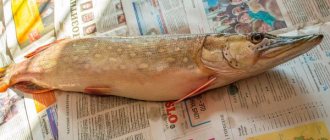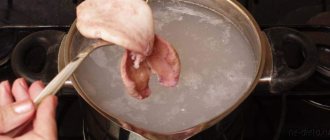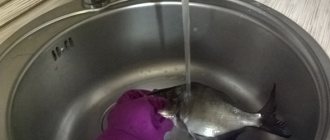Tench belongs to the class of river and lake fish of the carp family. It most likely got its name from its ability to change color: in air or in a shallow container with a small amount of water, dark spots appear on its thick, clumsy body - it begins to “molt.” Lives for a long time, sometimes more than 15 years: due to its passive lifestyle and habitat (at the bottom), it rarely becomes a victim of predators. An adult can reach large sizes: about 6-7 kg in weight and more than 50 cm in length.
Taste and nutritional qualities
Tench has quite tender fatty meat, which contains many useful vitamins and microelements that are perfectly absorbed by the human body. Moreover, it is low in calories, so it is ideal for a diet menu. Dishes from this fish were served on the royal table.
It is better to fry or bake tench, but you can boil it (a good option is in milk). It makes an excellent fish soup. Smoked tench will be a pleasant surprise. So the success of the dish is almost always ensured, because the fish is tasty in itself and if properly processed you will not spoil it.
With a lot of advantages, this representative of the river fauna raises one question in almost everyone: “How to properly clean tench?”
Getting rid of a specific odor
It is believed that the name “tench” did not come from its ability to shed, changing color, but because it leads a lazy lifestyle. Tench likes to burrow into mud to rest and search for food. This gives the fish pulp an odd, muddy odor. There are a few tricks to fix this before cooking:
| 1 | 2 | 3 | 4 |
| Immerse the carcass for some time in a solution of water and salt in a ratio of 1 l:2 tbsp. l. | Before cooking, soak in water with added citric acid or juice. Sometimes you can simply sprinkle the juice over the pulp. | When you need to cook, you can add your favorite herbs and spices to eliminate the specific aroma. | Place live fish in a large container (bath) with clean water. Let her swim there for about 12 hours. |
Why doesn't everyone like this fish?
Not knowing how to clean tench, many people, including fishermen, simply ignore such a catch. The fact is that its body is covered with small scales that fit tightly together and a thick layer of thick mucus. This makes the initial processing of fish difficult: it constantly slips out of your hands. In this case, the mucus is not washed off, and small scales are difficult to remove and scatter in all directions. But it is not all that bad. You just need to listen to the advice of people who know well how to clean tench fish, and the problem will be solved.
Is it necessary to remove the scales?
It is worth saying that tench is a somewhat unusual fish, since under the influence of high temperature the smallest scales tend to “dissolve.” After cooking, a rather tender and tasty crispy crust forms on its surface. As a result, the scales are not felt at all.
In general, it is preferable to eat unpeeled tench: in this case, it retains the maximum of nutrients. If, however, the fish is not accepted in this form, you can simply remove the skin from it before eating. And the question of whether it is necessary to clean tench before cooking will be practically resolved.
How to fry tench in a frying pan
Perhaps the easiest and fastest way to cook tench is to fry it in a frying pan. Remove the mucus, rip open the belly, remove the entrails, cut into steaks, salt and roll in flour. Pour a sufficient amount of vegetable oil into the frying pan and heat it up. The oil should be hot enough so that when you place the fish pieces in the pan, you can see a boil. The amount of oil should be such that it covers the fish by about half. Fry for a short time (the time depends on the temperature, size of the pieces, amount of oil), then turn over to the other side and fry it. That's it, the dish is ready.
You can add chopped onion and pepper to the fish, but this is a matter of taste. My opinion is that the more additional spices, the less real flavor of the tench itself remains.
An important point is that when eating undercooked river fish, there is a risk of becoming infected with parasites. Some of them are very dangerous for humans. Therefore, if you are not sure that the dish is exactly cooked, it is better to fry longer, especially for large pieces. They can easily end up browned on the outside but raw on the inside. If the fish has been in the freezer for several days, there is no need to worry. Extreme cold also kills parasites.
Fried tench in sour cream
Carefully clean the carcasses, cut off the heads and gut them. Remove the intestines carefully; if the gall bladder ruptures, the fish will begin to taste bitter.
Rub the cut carcasses with salt, sprinkle with black pepper and place in a frying pan. Fry for 10-15 minutes over low heat, don’t forget to turn them over. If the stove is electric, then set the average power.
Coat the lines with a layer of sour cream and sprinkle with a pinch of fresh herbs. Cover with a lid and simmer over low heat until fully cooked.
If desired, the finished fish can be decorated with olives. Fried tench turns out very tasty. Tender, fatty meat and a small number of bones, this dish is perfect for almost any side dish. Black pepper will add spiciness, and sour cream will add juiciness and excellent flavor.
How to cook tench in the oven by adding sour cream
We process tench carcasses in the same way as for frying. We remove the scales (for an amateur), gut them, cut off the heads, fins and tail. If there is enough free space on the baking sheet, you can bake the tench with its head.
Coat the belly with sour cream on all sides.
Sprinkle with salt with the expectation that when it is absorbed, the fish will not turn out over-salted or under-salted. Add pepper or prepared seasoning to taste on top. Let the carcasses marinate for one to two hours.
How to clean tench from mucus
If you can leave the scales before cooking, then you definitely need to get rid of the slippery coating. Usually there is quite a lot of mucus covering the entire body of the fish, so first you need to reduce its amount using, for example, a knife. Then the tench is washed well with water, preferably running water. All that remains is to get rid of the remaining mucus. To do this quickly and easily, just dip the fish first in boiling water and then in cold water. When exposed to hot temperatures, the mucus will begin to coagulate and then wash off quite easily. This contrast “shower” can be repeated several times. And so that the tench does not slip in your hands at this time, you can sprinkle them (and the fish, too, by the way) with coarse salt.
Some fishermen clean the mucus with salt: they simply rub the carcass with it and then rinse it off well. Several procedures – and the tench is clean.
Preparing tench for cleaning.
- Tench is a very slippery fish, making it difficult to cut. First of all, you should free it from mucus and stuck mud. This is the most difficult stage when cutting tench. And this must be done under the tap.
- Next, put it in the sink and pour boiling water over it. Thanks to this procedure, all the mucus coagulates like egg white.
- Rinse again under the tap. After this, wipe it dry with a kitchen napkin.
- To prevent slipping in your hand, sprinkle with salt. Preferably large.
- The next stage is getting rid of the internal organs. The procedure is done as follows. The knife is carefully inserted one or two centimeters into the abdominal area and passed to the lower part. Try not to touch the gallbladder, otherwise the bitterness of the fish will make itself felt. Then remove all contents from the fish, wrap in a tight bag and discard.
Removing scales
Of course, not everyone is ready to eat fish that has been cleaned only of mucus. Despite all their usefulness, scales are often embarrassing, and you still want to get rid of them. Here are a few methods tried and recommended by avid fishermen on how to clean tench.
The first option: put the fish in boiling water for a few seconds (the main thing is not to overcook it!), and then dip it in cold water. Next, place it on a cutting board and carefully scrape off the scales, moving from the tail to the head, using the blunt side of the knife. Some fishermen use homemade tools to clean tench. It is a piece of hacksaw blade for metal, to which a handle is attached on the bevel side of the teeth. To prevent the scales from scattering, the fish can be cleaned in a deep bowl of water.
Another tip on how to clean tench fish is to use a fine grater, preferably a tetrahedral one, instead of a knife. The wide base is very comfortable to hold with your hands, especially in the case of slippery lines. In addition, with this cleaning, the scales scatter less. The only condition: the grater must be sharp. You can build a convenient grater yourself. To do this, you will need a wooden block the size of a knife, on one edge of which a handle is made, and a metal plate (an old coffee can will do) with often punched holes is attached to the other. To make the grater safe and easy to clean, the wood must first be sanded.
Another tip on how to clean tench (this is appropriate in nature) is to grind it with coarse salt. For convenience, you can pour it on a sheet of paper or a piece of cloth in which you need to wrap the fish and rub the crystals on the scales. Or simply pour salt into a wide bowl, put the tench in it and rub it well with salt on both sides. Small scales will be removed along with the remaining mucus.
Who is Lin?
It is worth noting that tench is a predator; it feeds mainly on small larvae, less often on vegetation, and leads a sedentary lifestyle, which ultimately has a positive effect on the nutritional properties of this fish.
Experienced fishermen say that they came across specimens about 60 cm long and up to ten kilograms of live weight, even in places where other types of fish simply cannot survive.
Tench is quite unpretentious to such environmental factors as the oxygen content in water, which makes it easy to grow this representative of the fauna even in artificial reservoirs.
The lifestyle and dietary preferences of a living organism have a significant impact on its appearance. The tench is no exception, its body is covered with small golden scales, as well as mucus, which allows it to move effortlessly through the abundant vegetation and thickets of reeds characteristic of small bodies of water.
Some gourmets complain about the characteristic aroma of the meat of this fish, but only improperly cooked and prepared fish has a specific taste. We'll talk about how to clean tench a little later.
How to properly gut cleaned tench
If the answers to the question of whether it is necessary to clean the tench are ambiguous, then everything is simple here. They gut this fish the same way as any other: they cut open the abdomen with a sharp knife and take out the entrails, cut off the fins and, if necessary, the head. The only caution: in no case should you damage the bile bladder when cutting, so that the fish meat does not become bitter. If this happens, you need to carefully cut out the piece that got bile on it, rub the carcass with salt and rinse well. And one more tip: when cutting, it is recommended to remove the dark film on the walls of the abdomen from the inside.
Layering of defrosted and fresh tench
If you have to cook a large tench, after gutting it, you can perform flattening or filleting. This procedure is carried out the same way for fish of different species:
- Place the fully cleaned tench on a cutting board with its tail to your left.
- Press the carcass against the table with your left hand, and with your right hand, make an incision under the pectoral fin to the vertebral bone, using a sharp knife.
Filling is carried out in the same way for different types of fish
When filleting fish, use the knife as carefully as possible
The skin and remaining bones are removed from the fillet separated from the spine.
How to remove the skin from thawed or fresh fillets
If you want to make cutlets or quenelles from tench, you must remove the skin from the fillet. The scales do not need to be removed.
- With your left hand, hold the line by its tail.
- Using your right hand, trim the fillet with a sharp knife, pressing it firmly against the table surface, separating the meat from the skin.
- Place the fish fillet with the rib bones facing up.
- Holding the rib bones with your left palm, cut the bones with your right hand, holding the knife at an angle so that its blade points to your left.
- Do the same procedure with the second fillet.
When removing skin from fillets, it is advisable to use a sharp knife, acting as carefully as possible.
The waste remaining from the tench - fins, skin, bones - can be used to prepare broths. However, before the cooking process, it is necessary to remove the gills from the fish heads.
Using the methods described, you can easily clean and properly cut up tench before preparing a variety of dishes. Proper cleaning of tench, taking into account some important nuances, will allow you to avoid disappointment when tasting already cooked fish. And a variety of cutting methods will ensure your food is presented perfectly.
How to get rid of unpleasant odor
The tench spends the main part of its life in a calm state at the bottom of a river or lake (hence its everyday names “slow-moving” or “laziness” - from the word “lazy”). It looks for food in the mud and spends the whole winter there, so it has a strong smell of mud, which can persist during cooking and spoil the taste of the finished dish. You can get rid of the smell by keeping a gutted tench carcass in a saline solution: a couple of tablespoons of salt per liter of water. It is also advisable to sprinkle the fish with lemon juice before cooking. Seasonings added to the dish during its preparation will also remove the smell.
Some people keep live fish in clean fresh water for several hours - this also helps get rid of the smell of silt. This is exactly what they did in the old days: before cooking, they let it swim for several hours.
After you have completed such a difficult task as cleaning tench, you can send the fish for heat treatment. The easiest way is to grate with a small amount of salt, you can combine it with your favorite seasonings, grease the surface with oil, put a sprig of herbs in the belly - and into the oven or grill. Or cut into pieces and fry in a frying pan.
Compliance with the necessary conditions for processing and preparing tench becomes the key to the fact that this river fish quickly becomes one of your favorite dishes.
Features of cleaning and cutting frozen tench
Usually tench are cooked immediately without freezing. If you still have to work with frozen fish, then if it is not thawed properly, it may lose a number of its beneficial properties.
Before cleaning, it is necessary to properly defrost the tench.
Tench should be defrosted exclusively in cold water with a ratio of liquid to fish weight of 2:1. It takes about four hours for large fish to completely thaw, and no more than two hours for small fish. To prevent the loss of valuable substances, it is enough to put the tench in salted water. In this case, for 1 kg of tench you will need 2–3 liters of water and 15 g of salt.
When defrosting fillets, you can do without water. It is enough to place the pieces on the table, cover with cling film and leave until completely thawed at room temperature. Thanks to the film, the amount of evaporated moisture will be reduced, which will have a beneficial effect on the taste of the defrosted product. When working with frozen fillets, you should know that they do not require special hygienic treatment. Before cooking, cut off any damaged edges, remove dirt and rinse thoroughly.
You should not refreeze defrosted tench, as the fish will lose its taste due to loss of juice. In addition, it is advisable not to beat or squeeze the defrosted tench.
When defrosting fish, use only cold water.
It is recommended to not thaw the tench completely to simplify the processing of the carcass.
- If you plan to cook the fish whole or in portions, you can leave the scales before the frying process.
- If the scales need to be removed, you should use a knife, grater or special devices that make it easy to get rid of them. After cleaning is completed, it is necessary to remove the fins by cutting them on both sides and tearing them off from the carcass in the direction from the tail to the head.
Before preparing the soup, tench can be cut into large cross-sectional pieces. If you plan to fry it, it is recommended to cut the fish at an angle of 45 °C. Then salt and pepper the pieces and place in the refrigerator for 5 minutes. This will give the fish juiciness.
Tench, cut into large transverse pieces, is suitable for making soups











